
Woking is famed for the changes to the greens and bunkers the team of John Low and Stuart Paton effected in the first years of the 20th century. What isn't well known is that Paton (with the help of Low and occassionally other very well known archies) continued to make changes for nearly four decades! Both were long time members of Woking and well known in golf circles due to R&A Committee work. Additionally, Low was an excellent amateur golfer and author of Concerning Golf. In many ways, Low is a forgotten giant of the game. His stance against "fairness" as a foundation of the rules and architecture was not popular at the time. Where the rules are concerned it is debatable if his opinions were ever popular. Continuing with the rules, his fears about the quality of the ball have more or less come true. Low fought a fierce battle against the introduction of the Haskell because of what the future might bring via technology improvements. However, where design is concerned, Paton and Low's ideas on strategic design are very much the underpinning of the currrent renaissance being led by Doak, C&C etc.
The work on Woking's greens and bunkers continued for some years until the course was on equal footing with the reputation of the club. Darwin briefly relates the story in his Golf Courses of the British Isles. "Unconscious of their doom, the members disperse for their summer holidays and when they return they find that the most revolutionary things have been done. Upon greens that were formerly flat and easy have sprouted plateaus and domes and hollows. Hillocks have risen as if by magic in the middle of the fairway; 'floral' hazards bloom at the side, and bunkers have been dug at that precise spot where members have for years complacently watched their ball come to rest at the end of their finest shots."
John Low

The most well known and possibly most influential architectural change by the "Junta" was carried out on the 4th in the year 1902. A "Principal's Nose" bunker was placed in the left-centre of the fairway. The effect is a remarkable likeness to the tee shot on the 16th of The Old Course at St Andrews. This was not a coincidental change, but one appealing to the indestructible values of strategic links design. The middle section of a cross-rampart just shy of the green was also removed to encourage a running approach shot. These changes produced a clear-cut decision to be made on the tee. Play safely left and leave oneself with a difficult approach across a narrow opening of the green toward the railroad tracks (out of bounds) or take on the out of bounds and the bunker on the tee by threading a drive down the right and thus leaving a relatively easy approach.
This emphasis on tempting the golfer rather than punishing a poor shot perfectly describes one of John Low's main principles outlined in his Concerning Golf; published in 1903 and perhaps the first book on golf architecture. "The shortest, most direct line to the hole, even if it be the centre of the fairway, should be fraught with danger." This concept was more eloquently stated by Max Behr in later years: "The direct line to the hole is the line of instinct, and to make a good hole you must break up that line in order to create the line of charm." Dr Alister MacKenzie was also greatly influenced by the concept of the Line of Charm and believed no hole was a good one unless it has one or more hazards in the direct line of a hole. In hindsight it is easy to see why the team of Paton and Low are often credited with the re-birth of strategic design at a crucial time in architectural history when the great heathland courses and thus the great architects were only just emerging.
It is very strange to start on the short two-shotter first when the 14th has the obvious hallmarks of a finisher. Starting on the 15th has three clear advantages. First and foremost, it would allow the 14th, a mere few steps away from the house veranda, to be the home hole. Second, it breaks up Woking's two par 5s. Finally, one is properly warmed up and/or recovered from drink to give the first (which would be the 5th) the attention it merits. The walk around the clubhouse between 18 and 1 is quite short, not much further than from the lockeroom. It would be a simple matter to make the walk a bit more cheery; truth be told it should be made more attractive in any case.
The 2nd is the first of a good set of 3 pars. Curiously, three of the four play to roughly the same yardage, but they have a different look and set of shot requirements.
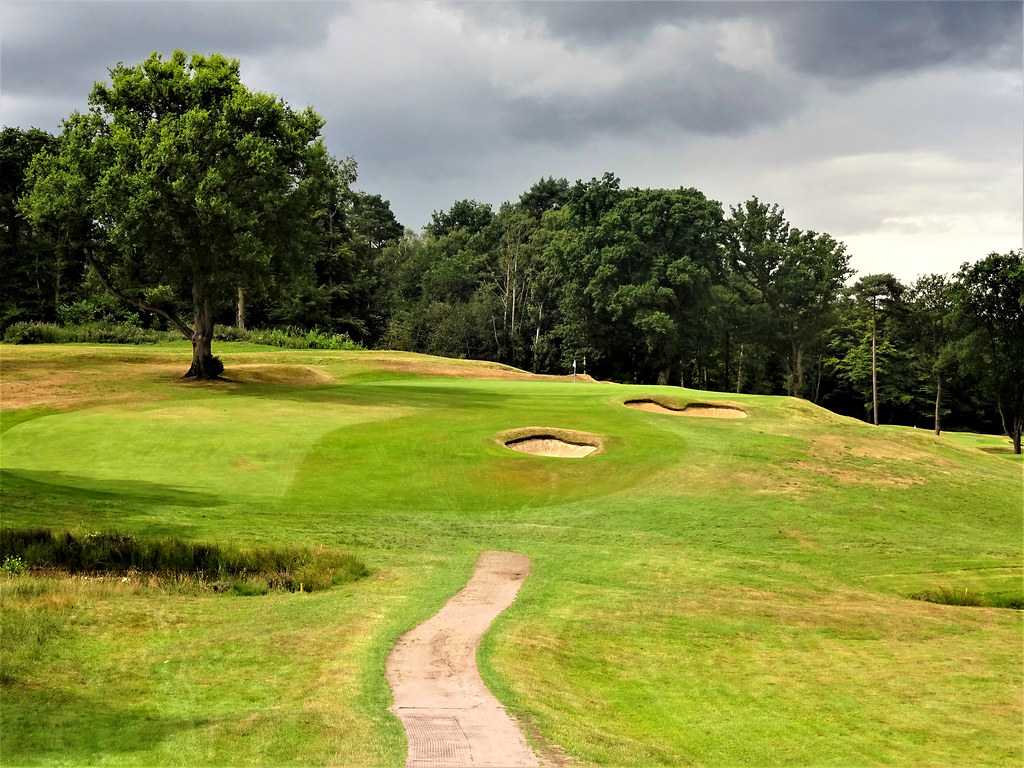
One shouldn't discuss Woking for long without mention of the first class greens. In my experience, conceptually, Woking's greens are among the best I have played. It was incredibly clever of Paton & Low to allow a handful of more subdued greens (especially the front to backers 1, 4 & 17) to create a devilish foil with the more unruly sort such as on 12, 13 & 15. The 2nd green.

Probably my favourite hole on the course - #3. The lay of the land pushes tee shots much further left than is at first apparent. I think the hole location, as is the case on many of Woking's holes, largely determines the best angle of attack. Luckily, due to the terrific clearing of trees in recent years, the hole location of the 3rd can be spied from the 1st fairway.

I can't think of a better placed bunker anywhere.
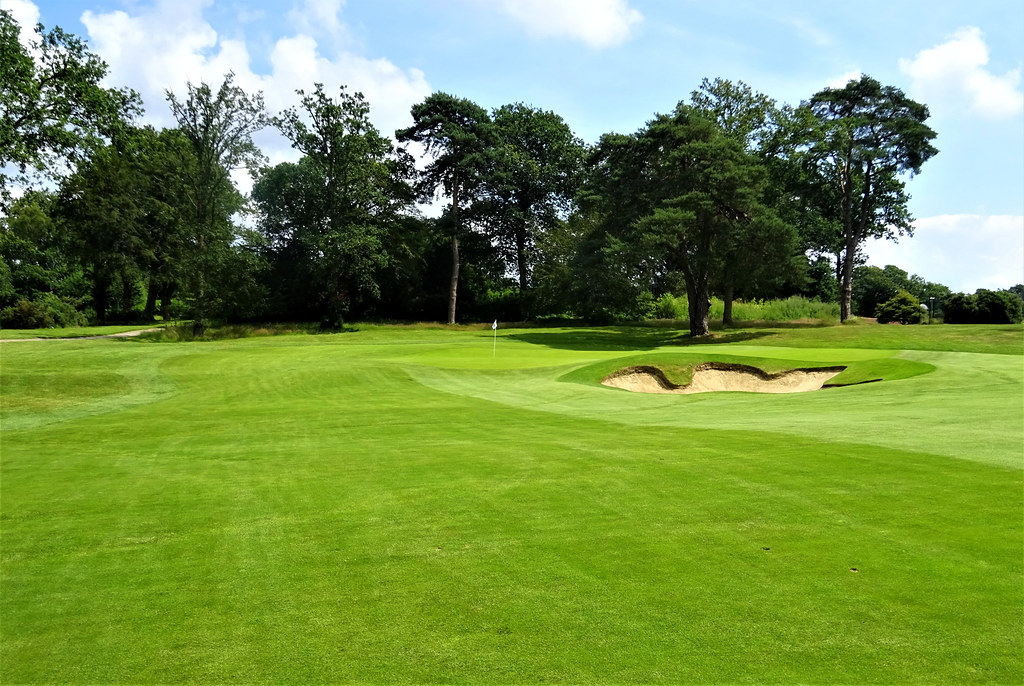


In recent years a left hand fairway bunker was added to the famous 4th. It seems to me that this bunker spoils the simple efficiency of the old scheme. Choosing to go left leaves an awful angle, that in essence is the rabbit line. The front to back nature of the green is a key feature of the hole which should get more notice. Darwin was involved in an interesting episode whilst playing this hole during a competition. After missing birdie putts on each of the opening trio of holes, Darwin then missed a three footer for a 3. He then fell to his hands and knees, tore a bit if the green away with his teeth and cried in a voice seething with anguish, "O God, are you satisfied now?"
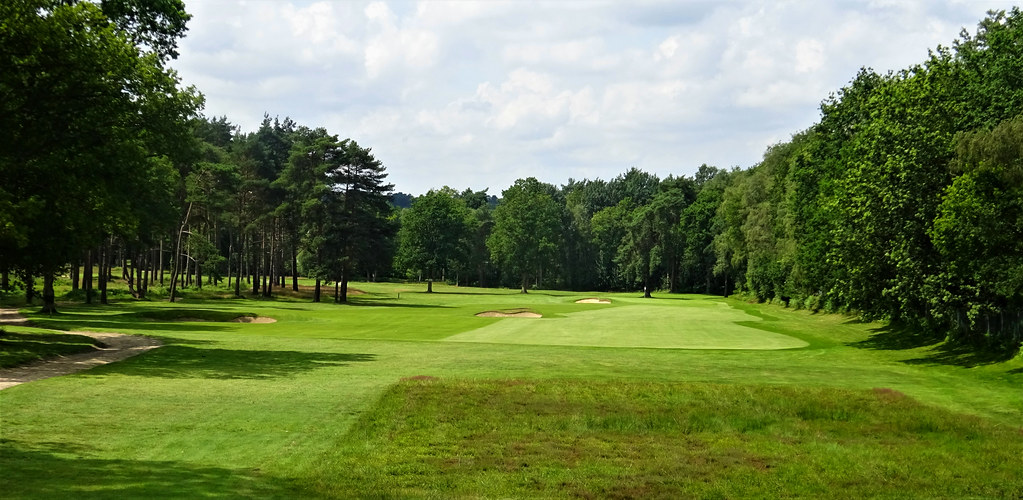
The 5th takes us up the hill which #s 2 & 3 work along.
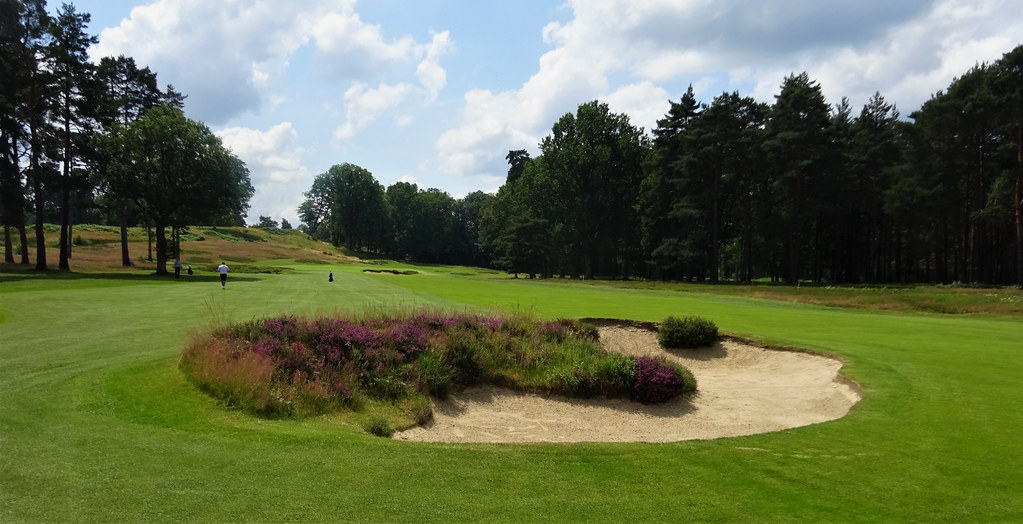
The 5th green from the 6th tee.

After the death of John Low in 1928, Paton (Mussolini of Woking) and Tom Simpson worked together making various changes which included diverting the stream on the 6th to make it a more meaningful hazard. Unfortunately the stream isn’t used to its full extent because the green doesn’t sit just behind it. As designed now, the water does not entice the player to take on a risky play.
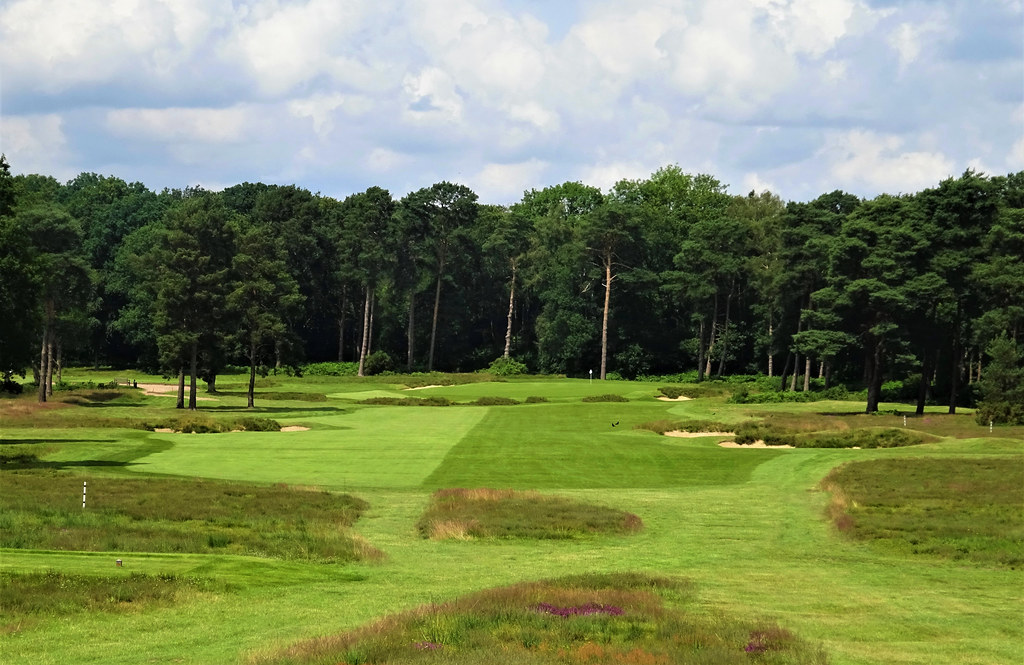
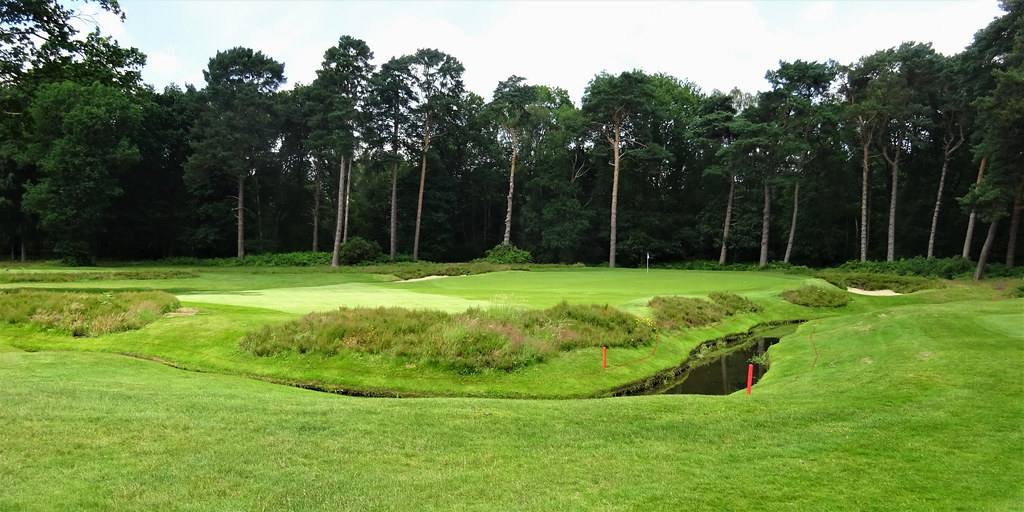
The 7th is the second short hole with all its trouble up front.
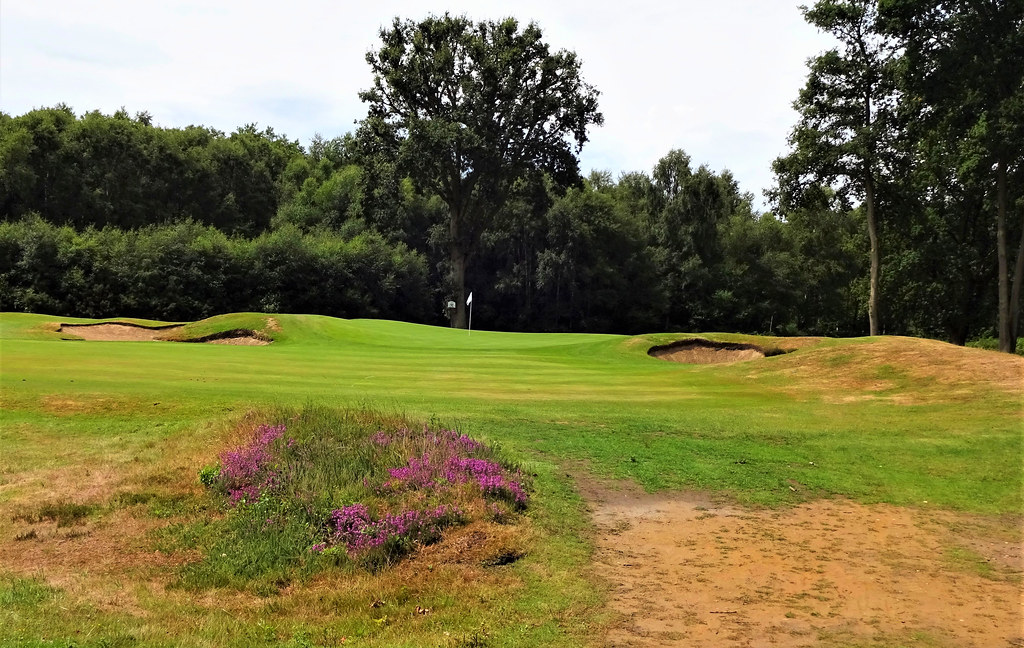
This photo is from well in front of the tee. It easy to see the left bunker has been reshaped, as have many bunkers.
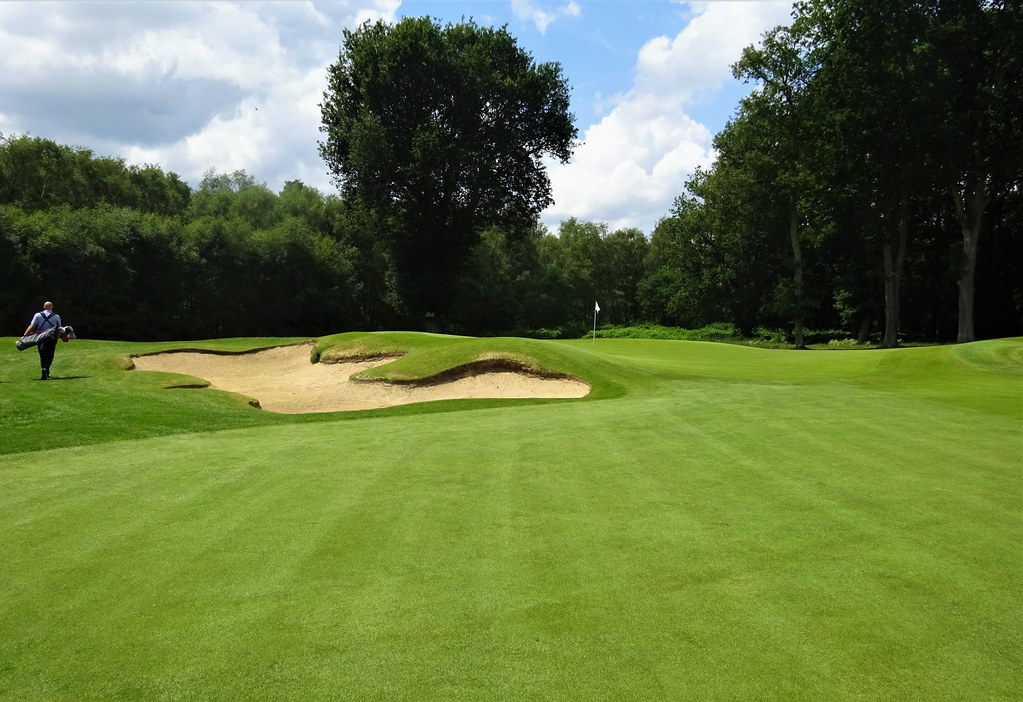
I always thought the 8th plays and looks a bit similar to the shorter 5th. One aspect I really like about this hole is that even though this is a slight dogleg, the green can be seen from the tee. A view of the green on leggers encourages players to hit toward it (the line of instinct) and often end up in trouble.
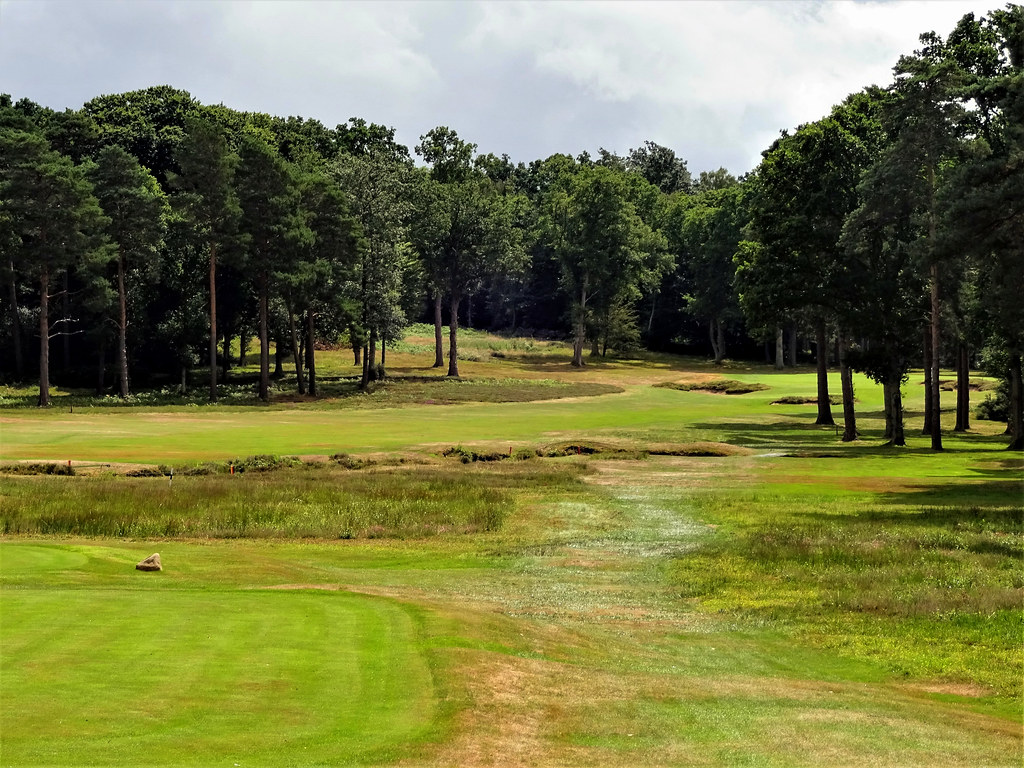
The approach shows off the lovely bunker work and the unusual placement of sand.
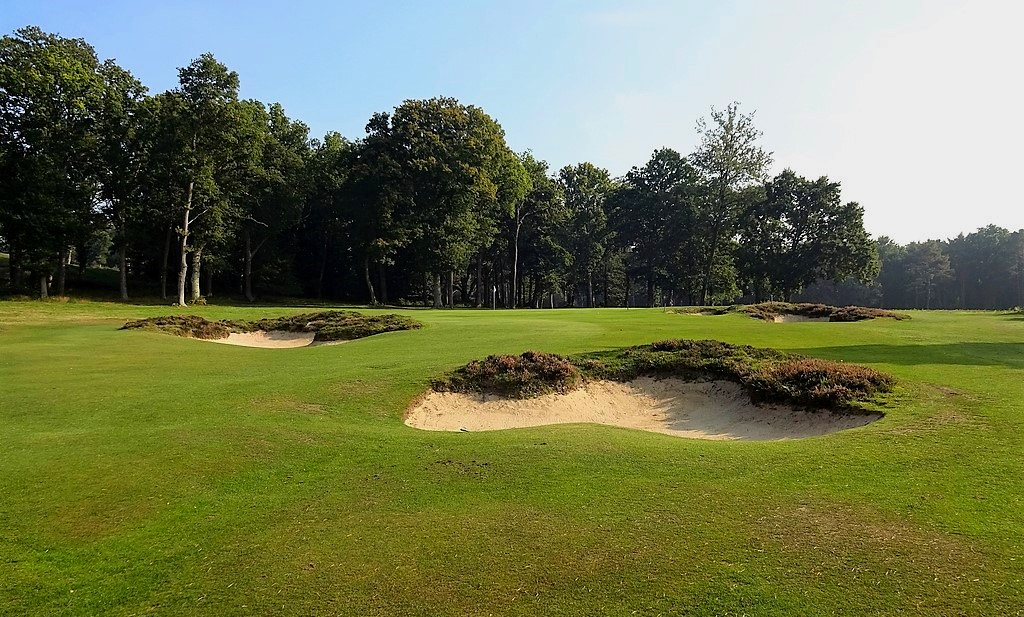
Irrespective of the rather less than handsome raised back tee, the one hole I am not sold on is the 9th. Its a tee shot where the flat belly has an obviously huge advantage as the left corner of trees can be carried where the likes of me has to go around. Normally this isn't a major issue; except the 9th is a reverse dogleg whereby the hill kicks tee shots out right, away from the target. Well, all great courses have to have a controversial hole and I reckon this is Woking's. I have to wonder if altering the 1937 Simpson designed hole was wise. On paper, the long par 4 (then 10th) seemed to be a winner with two centreline bunkers. I also suspect the long par 3 (then 9th) which played through the current 9th fairway from a tee behind 8 green was better than the current version whose genesis began in 1959. I think the changes were made in an effort help the scorecard (a crazy reason to alter a course) by adding another par 5. Well that par 5, the current 9th was determined to be a par 4 not too many years after it was built. Such irony.

The 10th features dead ground shy of the green which makes it hard to choose the right club. The green is slightly askew from the tee and a bit of an awkward angle because Simpson's hole came up the hill diagonally from a spot through the 9th fairway some 430 yards distant. If one looks from halfway up the 9th fairway, the green makes more sense.
Woking has a little bit of something for everyone. As such, it has to have red herring bunker or two and that is exactly what the bunker is on the right of the fairway of #11. Many can carry the bunker so folks will want to have a go, but the carry is for naught as the only reward is a stand of heather. Cleverly, there is a flat area just beyond the hill and tight to the heather. One will notice that nearly all of the approaches at Woking are either uphill or downhill. Many of the seemingly flat approaches are actually front to back running greens.
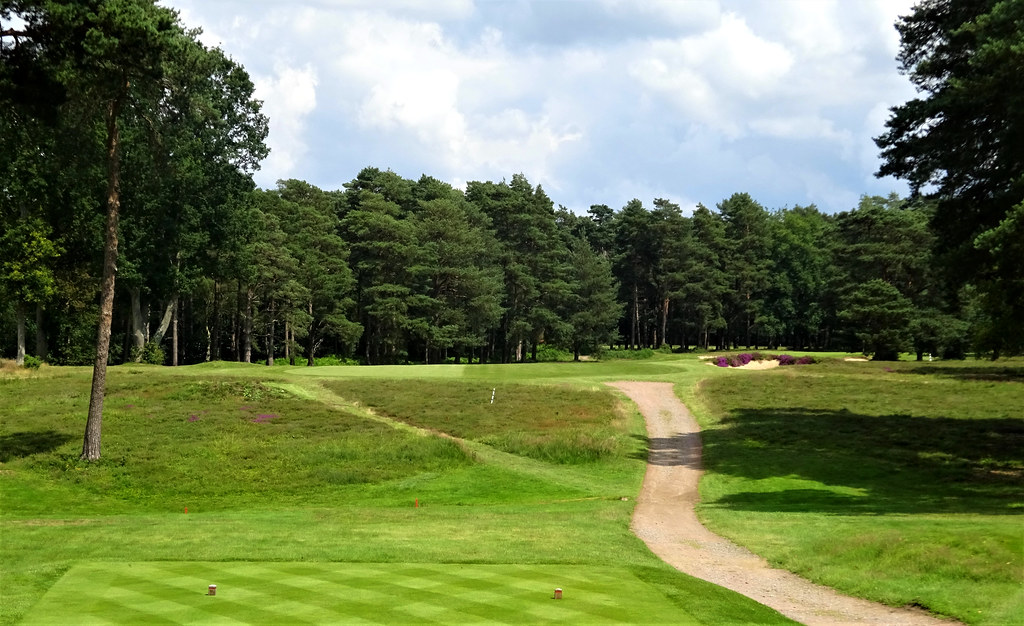
Turning back on the 11th, the 12th is another one of those holes in which it pays to preview the hole placement earlier in the round. I think there is a great opportunity to cut the trees down the right and continue the heather toward the green. Probably the wildest green on the course, but like #6, the green doesn't extend to the front left to make the all the bunkers matter as much as they should.
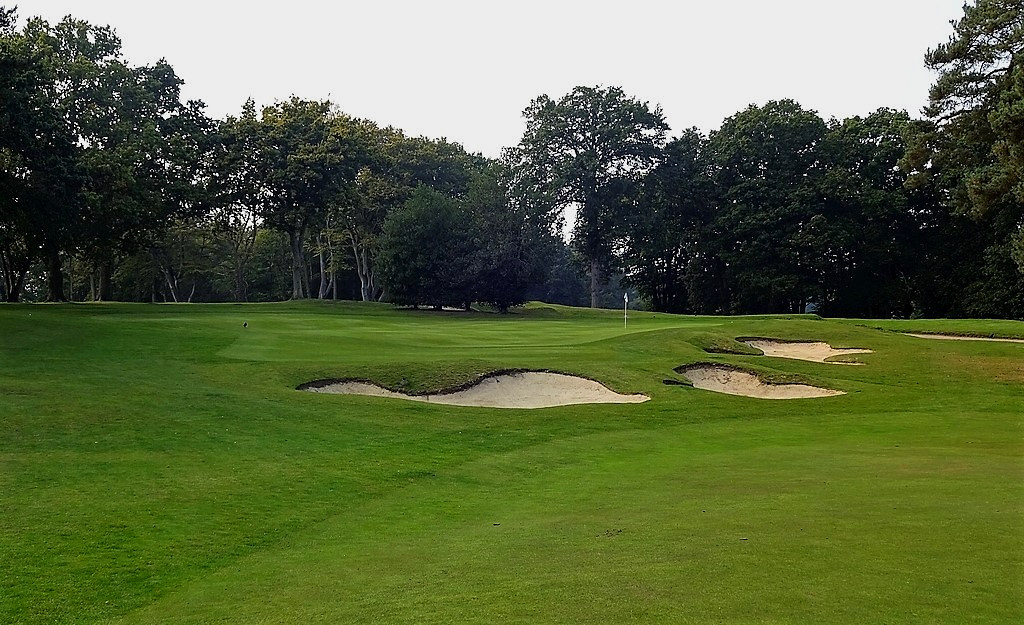
The green from just off the 11th tee.

Up to now the heather has mainly been a peripheral hazard which disciplines the wayward golfer. #s 13 and 14 create angles using the heather. The 13th slips left around a heather clad bunker. One will also sense the more enclosed nature and precision required from the tee.

Rear of the green featuring the slit.
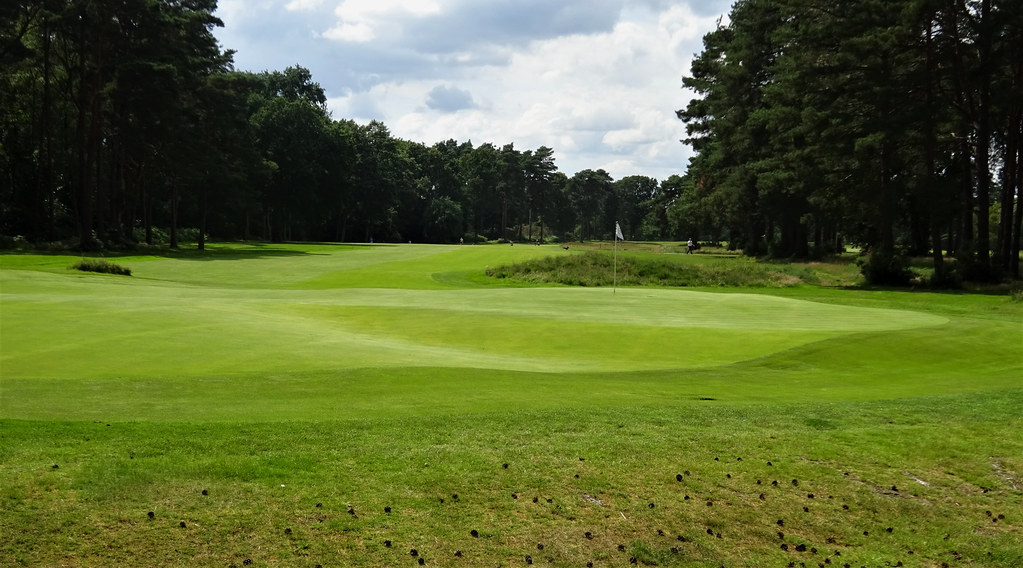
Trees well and truly begin to unnecesssarily encroach on the course...this is evident by the cool, damp climate and a less than full view of the house from the 14th tee. This feels like it should be the finishing hole, but its the first of two three-shotters, which happen to be back to back. The "safe" left side of the fairway drops significantly toward the trees. The player who successfully challenges the heather on the right is rewarded with a flat lie and a better view. A look at the green. There is a large elongated blind swale short of this green which stalls a long approach. In an effort to make sure shots climb this slope I reckon many must shoot through the green and end up on the veranda....which is in play.
Sadly, the roof is no longer in play.

Sadly, the roof is no longer in play.
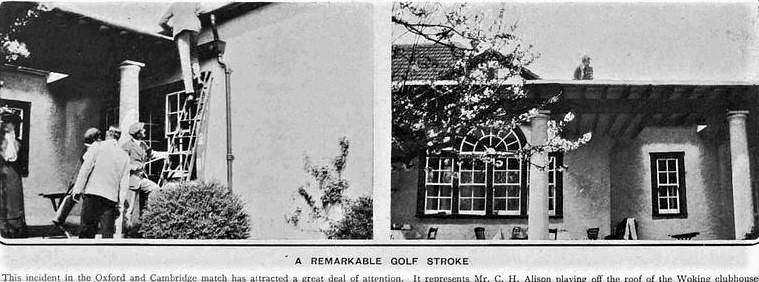
The old green looks a bit more rambunctious!

The 15th isn't an exciting hole, until reaching the green!
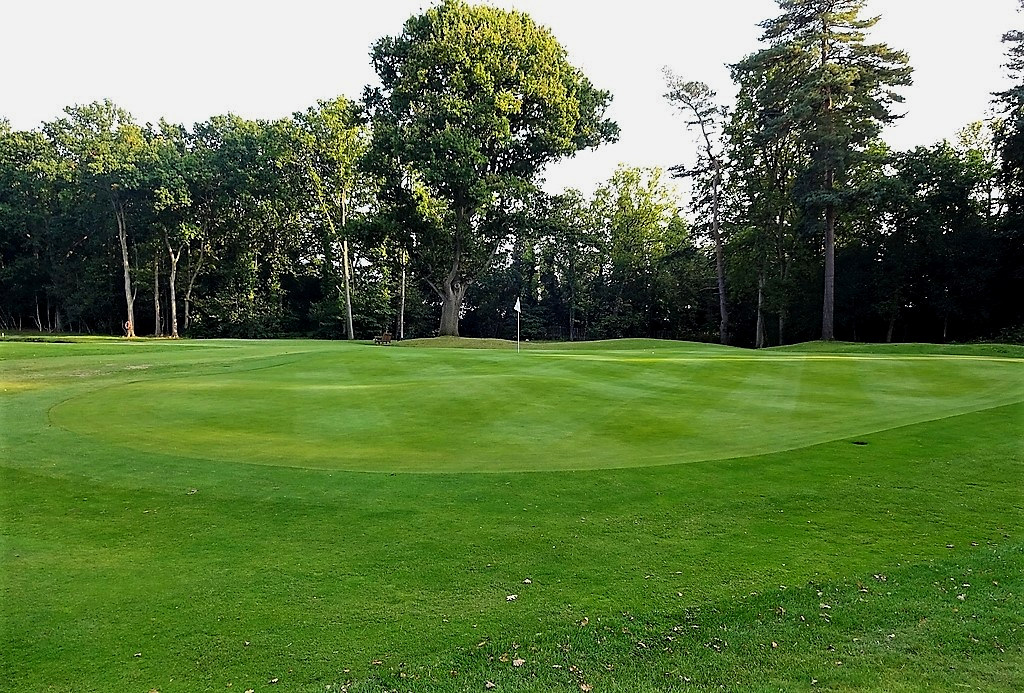
The final par 3 takes us over the pond. If I had to describe the hole in general terms I would say it looks like a modern links par 3. Maybe the archie tried a bit too hard to create something special because this strikes me as a visually busy hole. It was completed about 2013 and has been met with mixed reviews. The green is angled and narrow, leaving precious little space for hole locations. However, it was the large pimple near the rear of the green which didn't stand up to current maintenance practices. Rightfully so, the mound has been softened. The hole isn't far off being excellent, but perhaps more tree removal left and right and a bunker or two filled in would be in order. Given the very narrow target, it doesn't seem like four bunkers should required.

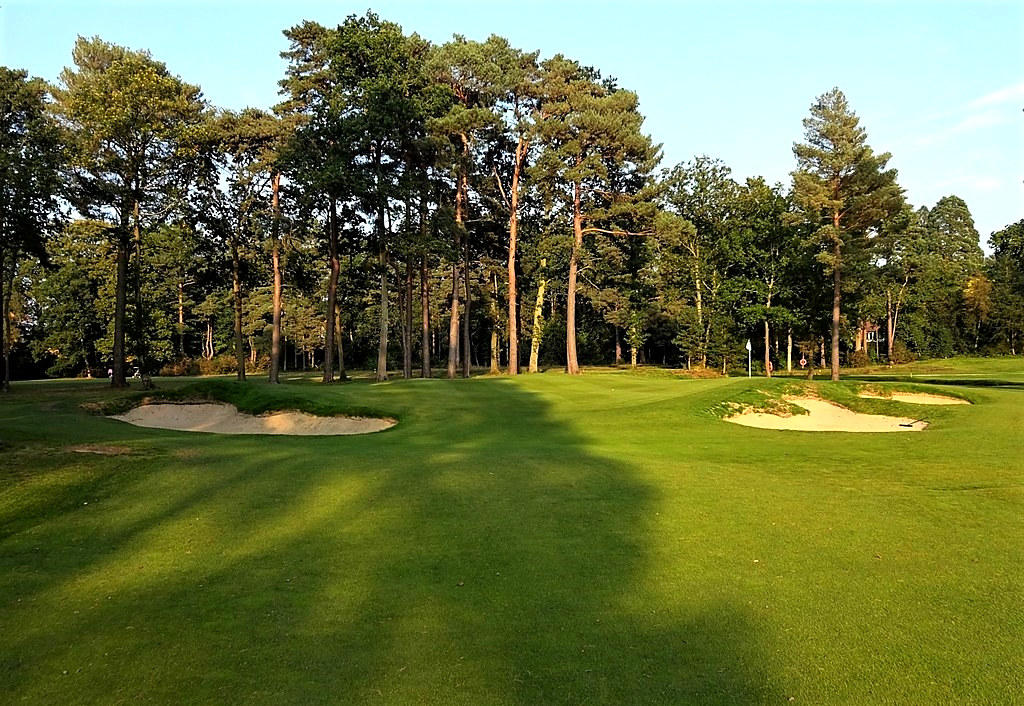
On the surface, the penultimate hole may seem a bit dull, but one must take great care with the approach to the severely front to back sloped green - my favourite on the course. It doesn't look it, but I reckon the green must drop at least two feet from front to back. I wonder if the right-front greenside sand is the famous Johnnie Low bunker; it could be that the green has shrunk. Much like the centreline bunkers on the 4th, this bunker set right into the green and forced a decision to be made. In other words, the bunker introduced temptation to the hole.
The final hole brings us home in a pleasant manner reminiscent of the finishers at TOC and North Berwick. Once again the line of instinct takes the golfer rather close to the water's edge. Unless one can drive the green, the line of charm is a wise road to take, well to the left on the house clock, but not literally as CH Alison did in the 1904 Oxford & Cambridge Society match. Incidentally, Alison earned a par! The heathery mound left of the fairway was recently introduced.
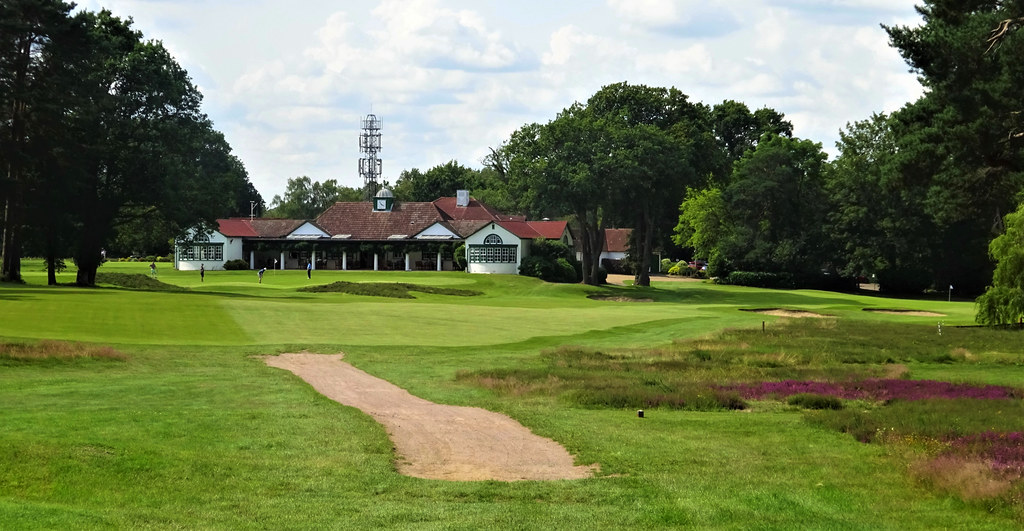
Due to golfers intinctively wanting to hit directly at the hole, many approaches are from this sort of angle.
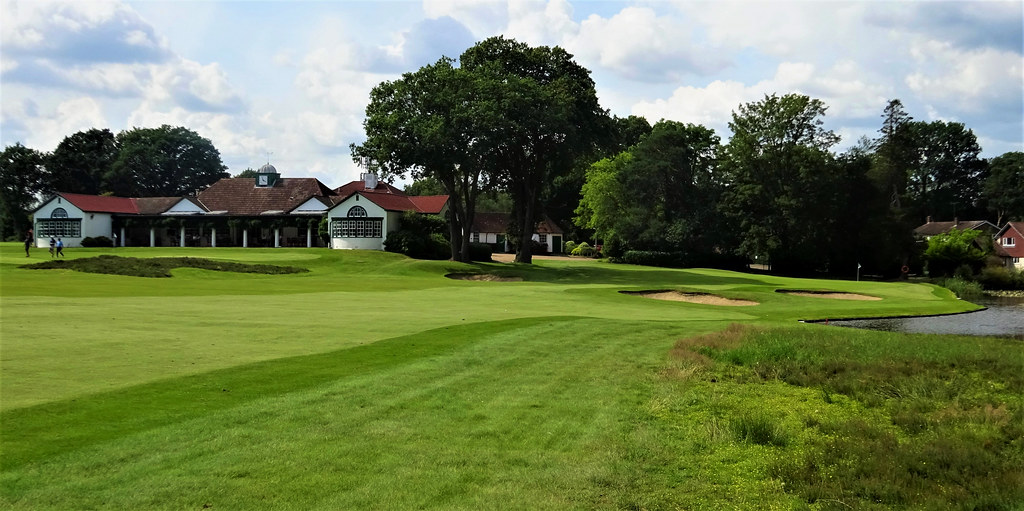
The green is a side by side three tiered affair sloping hard toward the water.

For a golfer looking to play a friendly game on a course which is not overly influenced by the overt trappings of championship golf, there are few better places than Woking. The course offers enough width to allow aggressive play, the walk is comfortable, the greens are without exception full of interest, there is an unusual variety of bunker placement and the club has an understated elegance which is very becoming. For those who believe that great courses must have great holes, I offer #s 3 & 4 as All-England candidates. Both are terrific par 4s whose bunker placement is among the very best in the world. Woking is one of my strong candidates for "If You Could Only Play One Course The Rest Of Your Life" and I hope this tour helps explain why. 1* 2021
Ran's Review.
http://golfclubatlas.com/courses-by-country/england/woking1/ Ciao